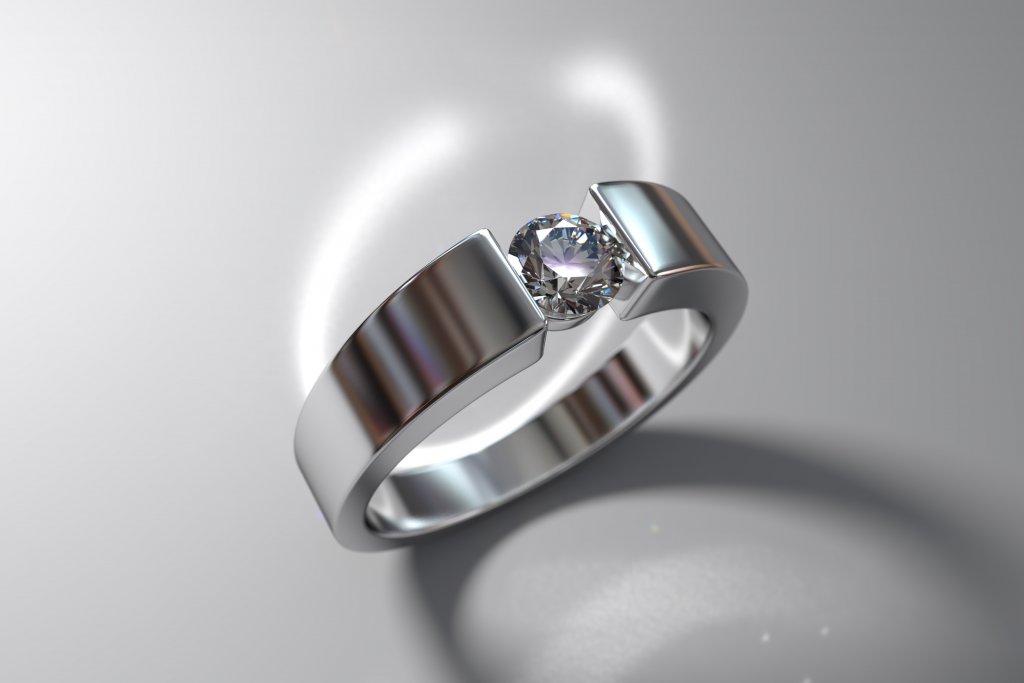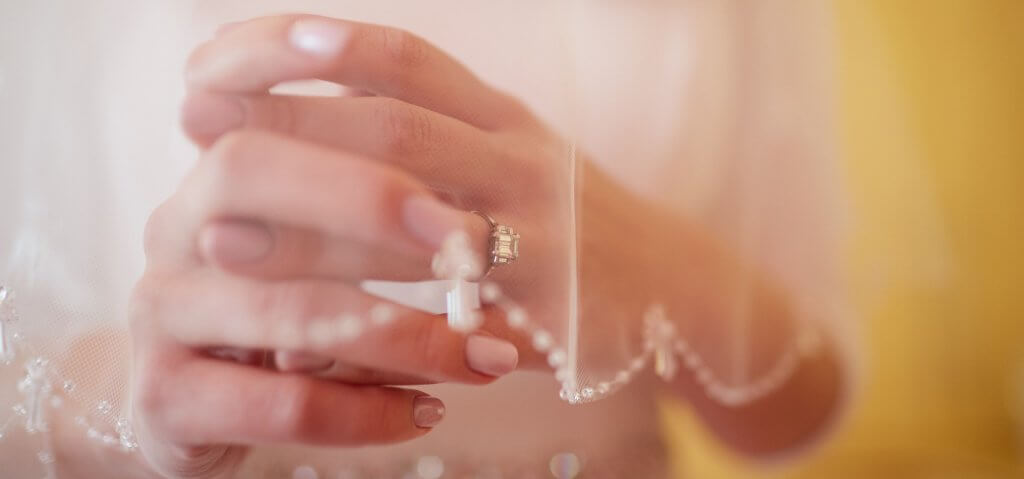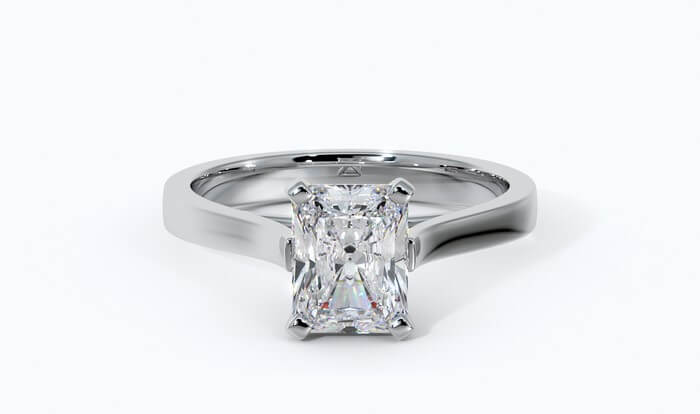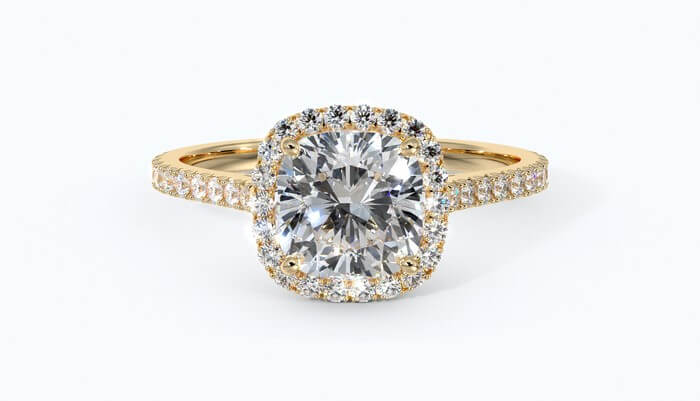The Ultimate Guide to Tension Settings
Key Takeaways
- The tension setting is unlike any other. Appearing to break the laws of physics, it is an example of how skilled and talented jewelers can really be.
- It may look fragile, but it is strong, sturdy and carefully designed to hold the diamond in resolutely in place.
- The metal of the band is important, however. If you are going down the road of a tension setting, then talk to your jeweler about what metal will be best to ensure the setting lasts.
- If you’re looking for a bigger diamond, and if your bride to be is open to going down a bit of a different route, then the tension setting is certainly one to look into.

There are so many ways jewelers can seemingly ‘bend’ the laws of physics when they set diamonds in metal, and one of the most fascinating has to be the tension setting.
These rings are capable of wrapping themselves around the finger like a piece of silk, and masking the strong forces operating on that diamond constantly, just to keep it in place. Contemporary, understated and highly sophisticated, they are a great example of the precision wielded by the world’s top jewelers, and their highly specialized tools.
What is a Tension Setting?
A setting that uses pressure to hold a diamond between the two ends of the metal band, rather than prongs or bezels, for instance.
If your first reaction is, “No way would I trust that to hold a $5,000 diamond in place,” then trust us when we say you’re not alone. But, while this setting appears to break the physical laws, it’s actually perfect proof of quite how unbreakable they are.
While it may look like fragile glass, a diamond is an incredibly strong mineral. In fact, no other naturally-occurring substance is strong. It can easily withstand continuous pressure, provided it is placed between those two metal ends with incredible skill and accuracy.
The effect is, in a word, exquisite. And, while the designs of these rings vary significantly, they all carry a somewhat futuristic appearance. The diamond seems to hover above the wearer’s finger, while the metal band seems to offer only the gentlest support to the diamond. It is hard to imagine the level of force between one and the other – or, at first, to believe it won’t disappear within a minute of wear.
Is the Tension Setting Safe?
Yes, on the proviso that it has been created by a highly accomplished professional jeweler.
To make something look so effortless actually requires a lot of effort – not to mention talent, time, and attention. You don’t want your ring to look like it’s been cut, clamped, and hammered into place – you want it to look organic and graceful. But, at the same time, you don’t want that simplicity to compromise the safety of your diamond.
So, the long answer to this question is this: a tension setting can be very secure, or it can be a risk. The only way to put your full confidence in this design is to find a reputable jeweler who knows what they’re doing, and how to get it right the first time. If you can do that, then the risk of your diamond working itself loose is incredibly small. It would take a major blow for the tension to be interrupted. Barring that, the diamond will stay put, even if it looks like it’s about to float off into the air like a feather.
Do Tension Rings Last?
Absolutely – but, again, this depends on the quality of their creation. They need to be made to a very high standard and, like any diamond ring, checked by the jeweler once or twice a year to make sure it’s not sustained any minor damage.
This also depends on the strength of the metal you choose.
If you’re going for a tension setting, then your jeweler will strongly recommend you pick a metal that won’t bend or get easily dented. Platinum on its own, or a lower karat gold alloyed with strengthening metals like copper or, of course, platinum. This still leaves you with plenty of choice – the white intensity of platinum, the romantic blush of rose gold, or the unmistakable yellow hue of gold – to make this design into the perfect ring for her.
Do Tension Set Diamonds Sparkle?
Yes, as the setting typically allows a lot of light to reach the diamond and sparkle in many different ways.
Each ring setting offers its own pros and cons when it comes to sparkle. While diamond will always react in that distinctive, mesmerizing way when moved under a light, candle, or the sun, you’ll only get the maximum effect when that diamond is free from any obstacles.
So, even when it’s sitting on the jeweler’s worktable before being set, its ability to interact with any light sources is being disrupted. Picture a diamond floating in the air, and you’ll be picturing the ‘idea’ conditions for a diamond to sparkle to its full potential.
Of course, levitating diamonds are impossible, but many jewelers would argue that the tension setting is the next best thing, since it holds the diamond up with the least contact possible.
While the exact among of contact between the band and the diamond will vary, many tension settings leave the diamond’s table, crown, pavilion, and cutlet exposed to the light, with just a small stretch of the girdle pinched by the metal.
This gives you an incredible amount of sparkle – a great option if you’ve invested a lot of money into a highly graded diamond, or if you’ve picked a cut with a very high number of facets (such as the round diamond) and want to gain as much benefit from them as possible.
What Diamond Cuts Can be Used in Tension Settings?
Diamonds of any shape can be held within these settings, although more balanced shapes like the round or princess cut typically look best – as well as diamonds with a larger carat weight.
In order to keep the diamond secure, the jeweler cuts a small channel (which will not be visible when the diamond is in place) into the metal. The girdle then fits into these channels, meaning that the diamond cannot shift around, even when pressure is exerted on it from above or below.
What does this mean for your diamond’s cut? It means that a very small amount of the diamond is ‘lost’ within these invisible channels.
For small diamonds, this can mean that they appear smaller when set within the band. Furthermore, if the diamond is cut into a more complex shape, such as a pear or heart, these small details can be obscured unless the stone is set at a particular angle.
This is why most tension settings you see will feature round diamonds. Both the Princess and Radiant cuts also look beautiful in this setting, as, like the Round cut, they feature a large number of facets – amplifying the diamond’s fire and brilliance – while also featuring a more modern, angular look.
What is a Tension-Style Setting?
These settings resemble the tension setting, although they do not actually keep the diamond in place via pressure. Instead more traditional setting, such as the four-pronged setting, is used to secure the diamond.
These are a great option if you love the effect of the tension setting, but would rather not put all your faith in tension alone. They offer a twist on the classic diamond solitaire ring, and allow you to show off a little more of your chosen metal by making a feature of the band.
Obviously, some of the impact of a true tension setting is lost. While subtle, the prongs will detract from the impression that the stone is somehow hovering a couple millimeters off the finger, although they will still allow plenty of light to shine through the diamond.
This doesn’t have to be a big deal but, if you’ve got your heart set on that gravity-defying look, you should go for the real deal instead.
Can a Tension Set Ring be Resized?
It’s possible, but will require a lot of skill and time and may cost a premium for that reason.
The design of this ring relies almost entirely on the band itself, rather than any additional setting that can be soldered to the top of a complete band. As a result, the band of a tension set ring cannot be made smaller or larger without this process affecting the amount of pressure it’s exerting on the diamond.
The jeweler may have to do some pretty major work on the ring where, in other styles, ring resizing is a pretty simple case of stretching or shrinking a part of the band.
So, Should You Pick a Tension Setting?
If the ring is intended for someone with a modern, sophisticated sense of style – and a whole lot of faith in the laws of physics – then consider this a strong contender.
Remember, however, that this setting is probably not the first thing that pops into most bride-to-be’s heads when they think of the traditional engagement ring. It may be that something going ‘against the grain’ is right up your partner’s alley, or it may be that they’d prefer something a little more ‘expected’.
Either way, the tension setting is a beautiful example of the creativity and ingenuity of jewelers – not to mention a great opportunity to get the most sparkle possible out of your diamond.
Keep in mind that you’ll want to know your bride-to-be’s ring size well in advance, to avoid the risk of having to get it resized – something that may turn out pretty expensive – and that small diamonds can look a little ‘lost’ in this setting.
Nevertheless, it’s a great choice – and one that will be sure to turn more than a few heads in the future.

Mar 17, 2022 By Willyou.net
Diamond Prong Setting Types: The Complete Guide

Mar 17, 2022 By Willyou.net
The Floating Diamond Engagement Ring Guide








